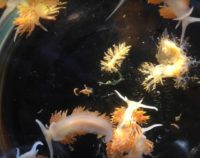
Japanese marine sea slugs photo: John Chapman
Another good news-bad news story. The good news is that the fears of radiation spreading across the Pacific from the Fukushima meltdown following the Japanese tsunami of 2011, have been wildly overstated. Yes, trace elements of radiation traceable to Fukushima have been recorded in Pacific fish, but they are barely above the level of naturally occurring background radiation. Or, as one analysis, described it, “turns out bananas are more radioactive than fish.”
The bad news is that the debris and trash propelled across the Pacific by force of the tsunami have acted as rafts for a wide range of invasive species, mostly invertebrates like mussels, sea anemones and crabs, which have been washing ashore on North American beaches for last seven years. The really bad news is that scientists are observing that many of these species are surviving and may, over time, pose a threat to indigenous plants and animals on the North American Pacific coast.
As reported by the National Geographic: Researchers collected as much of the debris as they could over the six-year period during which it continued washing onto West Coast shores. One study documented the creatures that came with the trash and found 289 Japanese species had survived the ride….
A Japanese algae species, for example, that had already spread to San Francisco and San Diego landed with the debris in Oregon. A Japanese shore crab, native to several parts of Asia, also rode the tsunami of trash to the West Coast. And scientists feared a shore mussel originally from the Mediterranean Sea could have carried with it a parasite that is not yet known to the West Coast of the U.S. and Canada.
Beyond specific events like the 2100 tsunami, some scientists are also concerned that the huge volume of floating plastics being introduced into the oceans every year provides the opportunity for invasive species to hitch rides on the floating plastic trash in any of the five major ocean gyres.

Pacific rafts with Japanese sealife hitting the west coast is news a least 2 or 3+ years old.
This was a natural event so only invasive species that hitched rides on man-made items should be destroyed.
Those that arrived on things like tree trunks should be left to find their own destiny. You can only take messing with mother nature so far.
Or not as may be. 🙂